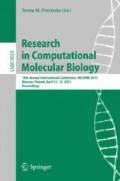Abstract
As populations with multilinear transmission (i.e., mixing of genetic material from two parents, say) evolve over generations, the genetic transmission lines constitute complicated networks. In contrast, unilinear transmission leads to simpler network structures (trees). The genetic exchange in multilinear transmission is further influenced by migration, incubation, mixing and so on. The task we address in the paper is to tease apart subtle admixtures from the usual interrelationships of related populations. We present a combinatorial approach based on persistence in topology to detect admixture in populations. We show, based on controlled simulations, that topological characteristics have the potential for detecting subtle admixture in related populations. We then apply the technique successfully to a set of avocado germplasm data indicating that the approach has the potential for novel characterizations of relatedness in populations. We believe that this approach also has the potential for not only detecting but also discriminating ancient from recent admixture.
Access this chapter
Tax calculation will be finalised at checkout
Purchases are for personal use only
Preview
Unable to display preview. Download preview PDF.
References
Browning, S., Browning, B.: Rapid and accurate haplotype phasing and missing-data inference for whole-genome association studies by use of localized haplotype clustering. The American Journal of Human Genetics 81(5), 1084–1097 (2007)
Carrieri, A.P., Utro, F., Parida, L.: Accurate and efficient sampling of underlying ARG of multiple populations under subdivision and admixture. Manuscript Under Submission (2015)
Edelsbrunner, H., Harer, J.L.: Computational topology. American Mathematical Society, Providence, RI (2010)
Freedman, M.L., Haiman, C.A., Patterson, N., McDonald, G.J., Tandon, A., Waliszewska, A., Penney, K., Steen, R.G., Ardlie, K., John, E.M., Oakley-Girvan, I., Whittemore, A.S., Cooney, K.A., Ingles, S.A., Altshuler, D., Henderson, B.E., Reich, D.: Admixture mapping identifies 8q24 as a prostate cancer risk locus in african-american men. Proceedings of the National Academy of Sciences 103(38), 14068–14073 (2006)
Greenbaum, B.D., Li, O.T., Poon, L.L., Levine, A.J., Rabadan, R.: Viral reassortment as an information exchange between viral segments. Proceedings of the National Academy of Sciences 109(9), 3341–3346 (2012)
Griffiths, R.C., Marjoram, P.: Ancestral inference from samples of dna sequences with recombination. Journal of Computational Biology 3(4), 479–502 (1996)
Javed, A., Pybus, M., Melè, M., Utro, F., Bertranpetit, J., Calafell, F., Parida, L.: IRiS: Construction of ARG network at genomic scales. Bioinformatics 27, 2448–2450 (2011)
Javed, A., Melé, M., Pybus, M., Zalloua, P., Haber, M., Comas, D., Netea, M.G., Balanovsky, O., Balanovska, E., Jin, L., et al.: Recombination networks as genetic markers in a human variation study of the old world. Human Genetics 131(4), 601–613 (2012)
Jobling, M., Hollox, E., Hurles, M., Kivisild, T., Tyler-Smith, C.: Human Evolutionary Genetics. Garland Science, UK (2013)
Kearsey, M., Pooni, H.: The Genetical Analysis of Quantitative Traits. Stanley Thornes, UK (2004)
Loh, P.R., Lipson, M., Patterson, N., Moorjani, P., Pickrell, J.K., Reich, D., Berger, B.: Inferring admixture histories of human populations using linkage disequilibrium. Genetics 193(4), 1233–1254 (2013)
Parida, L.: Ancestral Recombinations Graph: A reconstructability perspective using random-graphs framework. Journal of Computational Biology 17, 1345–1350 (2010)
Semon, M., Nielsen, R., Jones, M.P., McCouch, S.R.: The population structure of african cultivated rice oryza glaberrima (steud.) evidence for elevated levels of linkage disequilibrium caused by admixture with o. sativa and ecological adaptation. Genetics 169(3), 1639–1647 (2005)
Spanier, E.H.: Algebraic topology. McGraw-Hill Book Co., New York (1966)
Tausz, A., Vejdemo-Johansson, M., Adams, H.: Javaplex: A research software package for persistent (co)homology. Software (2011). http://javaplex.github.io/
Wall, J., Hammer, M.: Archaic admixture in the human genome. Current Opinion in Genetics & Development 16(6), 606–610 (2006)
Author information
Authors and Affiliations
Corresponding author
Editor information
Editors and Affiliations
Rights and permissions
Copyright information
© 2015 Springer International Publishing Switzerland
About this paper
Cite this paper
Parida, L., Utro, F., Yorukoglu, D., Carrieri, A.P., Kuhn, D., Basu, S. (2015). Topological Signatures for Population Admixture. In: Przytycka, T. (eds) Research in Computational Molecular Biology. RECOMB 2015. Lecture Notes in Computer Science(), vol 9029. Springer, Cham. https://doi.org/10.1007/978-3-319-16706-0_27
Download citation
DOI: https://doi.org/10.1007/978-3-319-16706-0_27
Published:
Publisher Name: Springer, Cham
Print ISBN: 978-3-319-16705-3
Online ISBN: 978-3-319-16706-0
eBook Packages: Computer ScienceComputer Science (R0)

